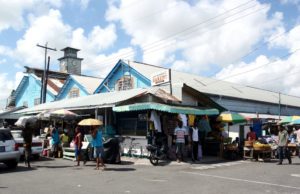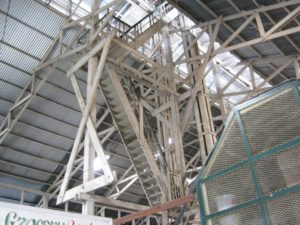In the late 19th century, the decision was made for the construction of a market that would stand the test of time in order to accommodate the increasing number of vendors in Georgetown; that market has survived to this very day.
While little official information appears available about the history of Bourda Market, previous unofficial research relates that Bourda market was originally built in 1880, and was soon reconstructed in 1902 to accommodate a growing number of vendors and consumers. 
The market got its name from the famous colonial, Joseph Bourda, who was also the proprietor of the Vlissengen Plantation, and was one of the many colonials who found their final resting place in the Bourda cemetery which is opposite the market. A place now neglected and overgrown with bush.
The actual Bourda market borders on the north and south by Robb and Regent Streets respectively, and on the east and west by Orange Walk and Bourda Street. The market has a long history that goes back to the 1870s when mention was just made of the Bourda market in the City Council’s minutes book.
The area in which the market is situated seems from very early in its history to have been where people gather to vend their produce on Saturday and Sunday afternoons. From this humble beginning the area later developed into a marketing centre.
Beginnings
According to Schulder Griffith, who was Clerk of Markets at the time of the study, vendors who normally occupied the Stabroek area came down to the Bourda area to do business after the construction of the Stabroek market began. As early as 1878, a shed was erected to accommodate the increase of vendors that now occupied the Bourda area. The Bourda Market was declared a temporary market in 1880.

The report of the City Council of 1881 asked the Council to decide whether to make the temporary structure which was the shed to become permanent. After three and a half years of existence, the shed had become unsafe and was therefore in need of much repair. The report added that if the market was to continue permanently it would be necessary to erect a more substantial building and fence it securely. The construction of Bourda Street and drains in the area was laid out in that same year.
The 1882 estimate of the City Council shows that a sum of $651.80 was set aside for enclosing the Bourda market an area of 125 x 50 feet approximately. The estimate also includes erecting and painting the fence. In 1901, a plan was prepared of a “new iron market” for Bourda, but due to the high prices for materials in that year, the decision was made to start construction in the following year. Provision was then made in the 1902 estimates for the construction of the new market.
Construction
The foundation stone of the Bourda market was laid on 12 December 1902 enclosing an area of 12,500 square feet, accommodating some 2,328 stalls. Bourda market, like Stabroek market, is enclosed with iron railing. It is a giant timber framed shed with three giant truss roves constructed of wood. A simple iron railed fence surrounds the entire structure. A clock tower was also constructed, which still exists though it is apparently not functioning.
This tower is not an imposing structure like its more famous sister, Stabroek Market is – people using the areas can go by the market without really noticing the clock tower. The Bourda Market clock was built by W Potts and Sons Makers of England in 1902. The clock bell is of cast bronze and weighs approximately 500 pounds. Legend has it that this bell is a commemorative bell cast for the coronation of England’s King Edward in 1902.

The market was later extended to include what was once called the Bourda Green. The Bourda Green was paved with concrete, and vending was permitted in the 60s, but the area was later organized and improved by requiring vendors to build stalls so as to remove their produce from off the ground. Further improvements were made as the area was provided with electricity, and stalls had to be made secure to prevent people from sleeping in them since the area that housed the Green was not enclosed.
The Bourda Green is a famous historic site because it was where the politicians in the 40s and 50s would gather to stage their political meetings. Many of them launched their political careers on that very ground. The vendors who occupied the Green were mostly from the East Coast of Demerara. The Green is now so filled to capacity that the Merriman’s Mall and an allotted space are used by vendors.
The Bourda Market is a very popular market, and is always buzzing with activity on a daily basis. Almost anything can be purchased in this market without having to go anywhere else.
While in need of repair, and in the shadow of the famous Stabroek Market, Bourda Market remains one of the most well-known and utilised traditional buildings in Georgetown. (Guyana Times Sunday Magazine)



